The libellous letters of the Chevalier d’Eon
Pre-trial statements held at The National Archives can reveal intricate details about cases heard in the Court of King’s Bench, as in this 1776 dispute between the Chevalier d’Eon and Charles de Morande.
‘Loud and hearty laughs of the whole court’
On 27 November 1776 in Westminster Hall, Lord Mansfield – Chief Justice of the Court of King’s Bench – presided over a libel case against the French blackmailer and spy Charles de Morande.
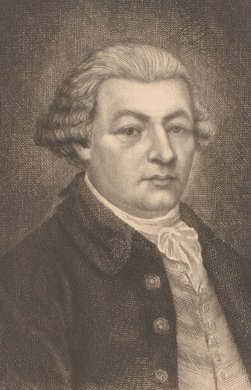
Portrait of Charles de Morande. Image: Penta Springs Limited / Alamy Stock Photo
Morande was accused of writing a defamatory letter about the Chevalier d’Eon, the French soldier, spy, and diplomat. This letter, first published in the magazine The Public Ledger on 10 September 1776, insisted that d’Eon was not a man, as d'Eon claimed in public letters and newspaper reports at the time, but a woman. The letter further alleged that d’Eon was directly involved in wagers betting 'on her sex, and that I [Morande] am able to prove it'.
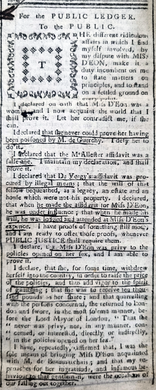
Transcript
For the PUBLIC LEDGER.
To the PUBLIC.
The different ridiculous affairs in which I find myself involved, by my dispute with MISS D’EON, make it a duty incumbent on me to state matters on principles, and to stand on a settled ground on every point.
I declared on oath that Miss D’Eon was a woman, and I now acquaint the world that I shall prove it. Let her contradict me, if she can.
I declared that she never could prove her having been poisoned by M. de Guerchy. I defy her to do it.
I declared that the McAllester affidavit was a false one. I maintain my declaration, and shall prove it.
I declared that De Vergy’s affidavit was procured by illegal means; that the will of that fellow bequeathed, as a legacy, an estate and a house which were not his property. I declared that when he made the affidavit for Miss D’Eon, he was under influence; that when he made his will, he was lodged and attended at Miss D’Eon’s expence. I have proofs of something still more, and I am ready to offer those proofs, whenever PUBLIC JUSTICE shall require them.
I declare that Miss D’Eon was privy to the policies opened on her sex, and I am able to prove it.
I declare, that she, for some time withdrew herself into the country, in order to raise the price of the policies, and thus add vigor to the spirit of gambling; that she was to receive ten thousand pounds as her share.
For the PUBLIC LEDGER.
To the PUBLIC.
The different ridiculous affairs in which I find myself involved, by my dispute with MISS D’EON, make it a duty incumbent on me to state matters on principles, and to stand on a settled ground on every point.
I declared on oath that Miss D’Eon was a woman, and I now acquaint the world that I shall prove it. Let her contradict me, if she can.
I declared that she never could prove her having been poisoned by M. de Guerchy. I defy her to do it.
I declared that the McAllester affidavit was a false one. I maintain my declaration, and shall prove it.
I declared that De Vergy’s affidavit was procured by illegal means; that the will of that fellow bequeathed, as a legacy, an estate and a house which were not his property. I declared that when he made the affidavit for Miss D’Eon, he was under influence; that when he made his will, he was lodged and attended at Miss D’Eon’s expence. I have proofs of something still more, and I am ready to offer those proofs, whenever PUBLIC JUSTICE shall require them.
I declare that Miss D’Eon was privy to the policies opened on her sex, and I am able to prove it.
I declare, that she, for some time withdrew herself into the country, in order to raise the price of the policies, and thus add vigor to the spirit of gambling; that she was to receive ten thousand pounds as her share.
Morande’s letter published in The Public Ledger, 10 September 1776, no 5219. Catalogue reference: KB 1/20/6/1
Rumours that the Chevalier d’Eon was a woman had been circulating since 1770. Such a tantalising rumour proved irresistible to the gamblers of 18th-century London, and by the time Morande and d’Eon appeared in King’s Bench in 1776, the highest criminal court in England, tens of thousands of pounds had been wagered – in the form of insurance policies – on d’Eon proving female. When these gamblers learned that d’Eon was due to appear in court in November 1776, many hoped that the case would provide a definitive statement on d’Eon’s sex.
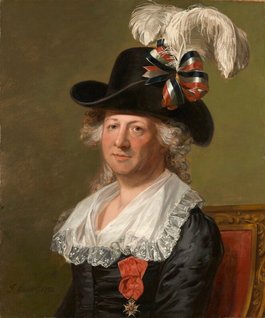
Chevalier d'Eon by Thomas Stewart, after Jean-Laurent Mosnier, in 1792. ©National Portrait Gallery, London, CC BY-NC-ND 3.0
But the November 1776 case wasn’t about d’Eon’s sex, rather whether Morande had written the libellous letter. When Morande’s counsel appeared in court on 27 November, their main argument was that d’Eon was just as guilty of writing libellous letters as he (allegedly) was. The King’s Bench typically did not entertain cases where the complainant was equally guilty of the offence they were alleging. To prove d’Eon’s guilt, Morande’s counsel produced letters written by d’Eon to Morande in which d’Eon insulted and threatened him. These letters were read out to the whole court on 27 November by Mr Bearcroft, one of Morande’s counsel, greatly amusing those in attendance. According to a report of proceedings published the following day in The Morning Chronicle:
There were so many out of the way, and ridiculous expressions in the Chevalier’s two letters to Mr De Morande, that Mr Bearcroft was repeatedly interrupted in his recital of them by the loud and hearty laughs of the whole Court.
The Morning Chronicle
These letters and the further defence of Morande’s counsel clearly convinced Lord Mansfield not to pursue the action, and he dismissed the case with just five words, ‘Let the Rule be discharged’.
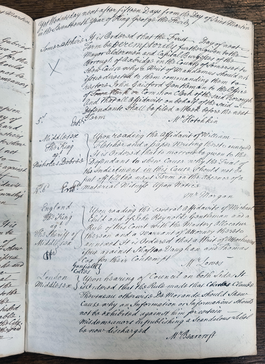
Partial transcript
London Middlesex
Upon hearing of Council on both sides, it is ordered that the Rule made that Charles Claude Theveneau otherwise De Morande should show cause why an information or informations should not be exhibited against him for certain misdemeanors in publishing a scandalous libel be now discharged.
London Middlesex
Upon hearing of Council on both sides, it is ordered that the Rule made that Charles Claude Theveneau otherwise De Morande should show cause why an information or informations should not be exhibited against him for certain misdemeanors in publishing a scandalous libel be now discharged.
Draft rule book entry dismissing the case against Charles de Morande, 27 November 1776. Catalogue reference: KB 36/235
18th-century king’s bench records
Details of this November 1776 case against Morande are all described in contemporary newspaper reports. They covered the main arguments put forward by both parties, the reactions from the crowd to the reading of d’Eon’s letters and Lord Mansfield’s dismissal of the case.. The main London newspapers sent reporters to sit in on court cases in Westminster Hall. In many instances, these reports contain more information than the records created by the court. Court records did not comment on what was said during proceedings, only matters of legal process such as the formal charges against the accused, whether they were found guilty, and what their punishment was.
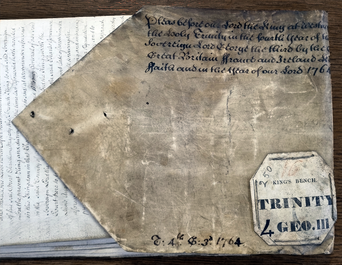
King’s Bench Plea Roll (Crown side) for Trinity term, 4 Geo III, 1764. Catalogue reference: KB 28/250
The two main record types for the Court of King’s Bench are the plea roll and the indictment. Plea rolls – for this period in KB 28 for Crown cases and KB 122 for civil cases – recorded the formal stages in a case. However, a case was only entered onto the plea roll when it proceeded to trial. In the libel case against Morande, Lord Mansfield dismissed the case before it reached this stage and therefore there is no plea roll entry. Indictments – in KB 10 and KB 11 for the 18th century – were the formal charges made against the accused. Again, though, the case against Morande never made it to this stage. The session on 27 November was to debate whether the court would submit formal charges against Morande.
In cases where the matter did not proceed to trial, then, we must rely on newspaper reports to provide much of the information about the case. But these reports do not include everything. Though they noted the crowd’s reaction to the reading of d’Eon’s letters, they don’t say what was in these letters. For this information, we need to look to another King’s Bench record series, KB 1, which contains affidavits, sworn statements, taken by the court for a variety of reasons.
The records in KB 1 contain statements relating to particular King’s Bench cases, not just from parties involved in the case but also from clerks of the court confirming process. This series also includes related documents such as newspapers and pamphlets, brought into court to present to witnesses or to support statements.
The records in KB 1 for the Morande case – held in KB 1/20/6/1, the bundle of affidavits for Michaelmas Term 1776 – are particularly rich. They include the sworn statements of d’Eon, Morande, and their witnesses, copies of the newspapers that published Morande’s libellous letter, and the letters written by d’Eon that Morande produced as evidence, which were subsequently read out in court.
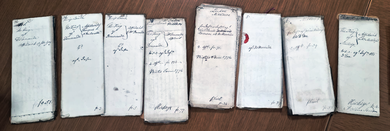
Affidavits and other documents brought in for the November 1776 case against Charles de Morande. Catalogue reference: KB 1/20/6/1
The libellous letters of the Chevalier d’Eon
Affidavits on behalf of d’Eon were the first to be taken. On 2 November 1776, the printer Thomas Brewman provided his testimony at Lord Mansfield’s house in Bloomsbury Square. He was the manager of The Public Ledger and confirmed that Morande had written the letter that his newspaper had published. Along with his affidavit was a copy of The Public Ledger for Tuesday 10 September, signed by Brewman, confirming that it contained a true copy of Morande’s original letter.
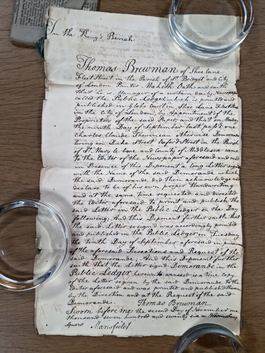
Transcript
In the King’s Bench.
Thomas Brewman of Shoe Lane, Fleet Street, in the parish of St Bridget and City of London, printer, maketh oath and saith that he is manager of a certain daily newspaper called the Public Ledger, which is printed and published in Globe Court in Shoe Lane, Fleet Street, in the City of London, by appointment of the proprietors of the said paper; and that on Monday the ninth day of September last pass’d one Charles Claude Theveneau otherwise Demorande living in Duke Street, Oxford Street, in the parish of St Mary le Bone and county of Middlesex, came to the editor of the newspaper aforesaid and read in presence of this deponent a long letter signed with the name of the said Demorande, which the said Demorande did then acknowledge and declare to be of his own proper handwriting, and at the same time requested and directed the editor aforesaid to print and publish the said letter in the Public Ledger on the day following; And this deponent further saith that the said letter so signed was accordingly printed and published in the Public Ledger on Tuesday the tenth day of September aforesaid in pursuance of the aforesaid directions and request of the said Demorande; And this deponent further saith that the letter signed Demorande in the Public Ledger hereunto annexed is a true copy of the letter so given by the said Demorande to the editor aforesaid and was printed and published therein by the direction and at the request of the said Demorande.
In the King’s Bench.
Thomas Brewman of Shoe Lane, Fleet Street, in the parish of St Bridget and City of London, printer, maketh oath and saith that he is manager of a certain daily newspaper called the Public Ledger, which is printed and published in Globe Court in Shoe Lane, Fleet Street, in the City of London, by appointment of the proprietors of the said paper; and that on Monday the ninth day of September last pass’d one Charles Claude Theveneau otherwise Demorande living in Duke Street, Oxford Street, in the parish of St Mary le Bone and county of Middlesex, came to the editor of the newspaper aforesaid and read in presence of this deponent a long letter signed with the name of the said Demorande, which the said Demorande did then acknowledge and declare to be of his own proper handwriting, and at the same time requested and directed the editor aforesaid to print and publish the said letter in the Public Ledger on the day following; And this deponent further saith that the said letter so signed was accordingly printed and published in the Public Ledger on Tuesday the tenth day of September aforesaid in pursuance of the aforesaid directions and request of the said Demorande; And this deponent further saith that the letter signed Demorande in the Public Ledger hereunto annexed is a true copy of the letter so given by the said Demorande to the editor aforesaid and was printed and published therein by the direction and at the request of the said Demorande.
Affidavit of Thomas Brewman, taken 2 November 1776. Catalogue reference: KB 1/20/6/1
Four days later, on 6 November, d’Eon appeared in court to swear affidavits against Morande and the printer Josiah Millidge, who had printed Morande’s letter in the 14 September edition of The Westminster Gazette. Enclosed with d’Eon’s affidavit against Morande is another copy of The Public Ledger. The newspaper has several underlined passages, pertinent to the libel accusations against Morande, including his claim that:
Miss D’Eon was privy to the policies opened on her sex, and I [Morande] am able to prove it. I declare, that she, for some time, withdrew herself into the country, in order to raise the price of the policies, and thus add vigor to the spirit of gambling; that she was to receive ten thousand pounds as her share.
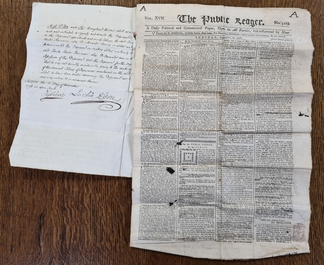
Affidavit of the Chevalier D’Eon, taken 6 November 1776, with a copy of The Public Ledger attached. Catalogue reference: KB 1/20/6/1
Following the affidavits sworn on behalf of d’Eon, the court summoned Morande and his witnesses to provide statements. On 16 November, Elizabeth de Morande, Charles de Morande’s wife, told the court that d’Eon had continually challenged her husband to duel and men had appeared at her house in August that year threatening to duel (and kill) her husband.
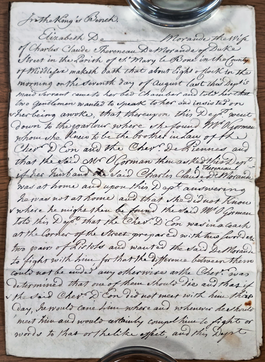
Transcript
In the King’s Bench.
Elizabeth De Morande, the wife of Charles Claude Theveneau De Morande of Duke Street in the parish of St Mary le Bone in the county of Middlesex maketh oath that about eight o clock in the morning on the seventh day of August last this deponent's maid servant came to her bed chamber and told her that two gentlemen wanted to speak to her and insisted on her being awoke, that thereupon this deponent went down to the parlour where she found Mr O'Gorman whom she knew to be the brother in law of the Chevalier D'Eon and the Chevalier De Piennes, and that the said Mr O'Gorman then asked this deponent if her husband the said Charles Claude Theveneau De Morande was at home and upon this deponent answering he was not at home and that she did not know where he might then be found, the said Mr O'Gorman told this deponent that the Chevalier D'Eon was in a coach at the corner of the street prepared with two swords and two pairs of pistols and wanted the said De Morande to fight with him, for that the difference between them could not be ended any otherwise, and the Chevalier was determined that one of them should die, and that if the said Chevalier D'Eon did not meet with him that day, he would cane him where and whenever he should meet him and would certainly compel him to fight or words to that or the like effect…
In the King’s Bench.
Elizabeth De Morande, the wife of Charles Claude Theveneau De Morande of Duke Street in the parish of St Mary le Bone in the county of Middlesex maketh oath that about eight o clock in the morning on the seventh day of August last this deponent's maid servant came to her bed chamber and told her that two gentlemen wanted to speak to her and insisted on her being awoke, that thereupon this deponent went down to the parlour where she found Mr O'Gorman whom she knew to be the brother in law of the Chevalier D'Eon and the Chevalier De Piennes, and that the said Mr O'Gorman then asked this deponent if her husband the said Charles Claude Theveneau De Morande was at home and upon this deponent answering he was not at home and that she did not know where he might then be found, the said Mr O'Gorman told this deponent that the Chevalier D'Eon was in a coach at the corner of the street prepared with two swords and two pairs of pistols and wanted the said De Morande to fight with him, for that the difference between them could not be ended any otherwise, and the Chevalier was determined that one of them should die, and that if the said Chevalier D'Eon did not meet with him that day, he would cane him where and whenever he should meet him and would certainly compel him to fight or words to that or the like effect…
Affidavit of Elizabeth de Morande, taken 16 November 1776. Catalogue reference: KB 1/20/6/1
Charles de Morande provided his statement on 18 November. He brought with him three letters written by d’Eon, marked ‘A’, ‘B’, and ‘C’, which he claimed proved that d’Eon was firstly a woman and secondly was guilty of writing seditious letters.
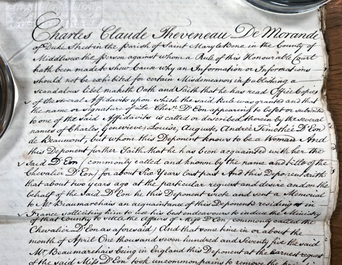
Transcript
Charles Claude Theveneau De Morande of Duke Street in the parish of Saint Marylebone in the county of Middlesex, the person against whom a rule of this honourable court hath been made to show cause why an information or informations should not be exhibited for certain misdemeanours in publishing a scandalous libel, maketh oath and saith that he has read office copies of the several affidavits upon which the said rule was granted and that the name or signature of Le Chevalier D'Eon appearing to beset or subscribed to one of the said affidavits is called or described therein by the several names of Charles Genevieve Louise Auguste Andrée Timothee D'Eon de Beaumont, but whom this deponent knows to be a woman. And this deponent further saith that he has been acquainted with her the said D’Eon (commonly called and known by the name and title of the Chevalier D’Eon) for about six years last past.
Charles Claude Theveneau De Morande of Duke Street in the parish of Saint Marylebone in the county of Middlesex, the person against whom a rule of this honourable court hath been made to show cause why an information or informations should not be exhibited for certain misdemeanours in publishing a scandalous libel, maketh oath and saith that he has read office copies of the several affidavits upon which the said rule was granted and that the name or signature of Le Chevalier D'Eon appearing to beset or subscribed to one of the said affidavits is called or described therein by the several names of Charles Genevieve Louise Auguste Andrée Timothee D'Eon de Beaumont, but whom this deponent knows to be a woman. And this deponent further saith that he has been acquainted with her the said D’Eon (commonly called and known by the name and title of the Chevalier D’Eon) for about six years last past.
Affidavit of Charles de Morande, taken 18 November 1776. Catalogue reference: KB 1/20/6/1
The first letter, ‘Exhibit A’, was a certificate of sauf-conduit (safe conduct) that the French king Louis XVI had granted to d’Eon in August 1775. This certificate acknowledged that d’Eon was a woman and Morande claimed that it was d’Eon that had requested that the certificate be changed to refer to d’Eon as female.
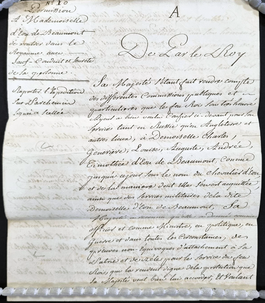
Translation
A.
In the King’s name.
His Majesty having caused information to be laid before him of the different public and private commissions which the late King, his most honoured grandfather, has been pleased to entrust formerly for his service, as well in Russia as in England and other places, Demoiselle Charles Genevieve Louise Auguste Andrée Timothee d'Eon de Beaumont, hitherto known by the name of the Chevalier D’Eon, and of the manner in which she executed them; as also of the said Demoiselle D’Eon de Beaumont’s military services; his Majesty has seen that as an officer and as a minister, in politics, in war, and in all circumstances, she has given doubtless proofs of attachment to her country and of zeal for the late King’s service, which render her worthy of the protection, which his Majesty is pleased to grant her…
…Moreover willing his Majesty that in no case whatever, at any time, in no place, the said Demoiselle D’Eon shall be troubled, disquieted or molested in her honour, her person, or her fortune, by any of the ministers past, present, and future, nor by any other persons, as well in regard to the negotiations and commissions public and secret with which the late king had honoured her, as to any of her cases resulting from her quarrels, disputes, and law-suits, which are forever annihilated by these presents…
Versailles the 25th August 1775.
A.
In the King’s name.
His Majesty having caused information to be laid before him of the different public and private commissions which the late King, his most honoured grandfather, has been pleased to entrust formerly for his service, as well in Russia as in England and other places, Demoiselle Charles Genevieve Louise Auguste Andrée Timothee d'Eon de Beaumont, hitherto known by the name of the Chevalier D’Eon, and of the manner in which she executed them; as also of the said Demoiselle D’Eon de Beaumont’s military services; his Majesty has seen that as an officer and as a minister, in politics, in war, and in all circumstances, she has given doubtless proofs of attachment to her country and of zeal for the late King’s service, which render her worthy of the protection, which his Majesty is pleased to grant her…
…Moreover willing his Majesty that in no case whatever, at any time, in no place, the said Demoiselle D’Eon shall be troubled, disquieted or molested in her honour, her person, or her fortune, by any of the ministers past, present, and future, nor by any other persons, as well in regard to the negotiations and commissions public and secret with which the late king had honoured her, as to any of her cases resulting from her quarrels, disputes, and law-suits, which are forever annihilated by these presents…
Versailles the 25th August 1775.
Copy of d’Eon’s certificate of Sauf-conduit, granted by the King of France. August 1775. Catalogue reference: KB 1/20/6/1
The second and third letters, both written by d’Eon to Morande in August 1776, were the ones read out in court on 27 November 1776.
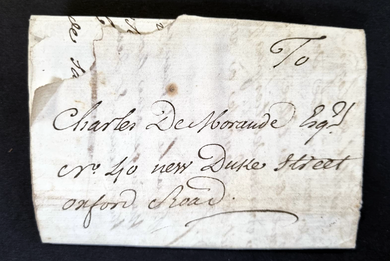
Letter sent by the Chevalier d’Eon to Charles de Morande, 3 August 1776. Catalogue reference: KB 1/20/6/1
In the first of these, d’Eon accused Morande of being a man that ‘subsists only in London on the dirt of his libels’. D’Eon had continually challenged Morande to duel throughout 1776, though Morande – believing d’Eon to be a woman – continually refused. In the letter, written by d’Eon as ‘Mademoiselle d’Eon’, she says that if Morande would not duel a woman, then her ‘brother’ the Chevalier d’Eon would duel in her place. Mademoiselle d’Eon remarked that:
She pities her [Mrs de Morande] very sincerely to have for a husband a man so corrupted, so wrongheaded, and so fiery, who is only dangerous to women and children; but not at all to the Chevalier d’Eon.
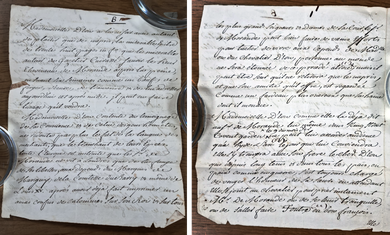
Translation
Mademoiselle D’Eon has read this evening with as much pleasure as contempt the pitiful epistle of thirty eight pages in so which the pitiful author of the Gazetier Cuirasee viz. Mr Theveneau de Morande has taken the trouble, after sweating as an ox for six weeks, to forge to write…
…all Europe knows that Mr De Morande subsists only in London on the dirt of his libels…
…Mademoiselle D’Eon as she has already told to Mr de Morande himself in King Street Covent Garden the 9th of the last month cannot grant him audience but in Hyde Park; the day that will suit him, she will repair there with her brother the Chevalier D’Eon who since long ago and in all counties either in a time of war or peace has always taken upon him to vindicate his sister’s honour, in the mean time she joins with the Chevalier in requesting earnestly Mr De Morande either to keep himself quiet or to go and get himself bougred in good French, she is very sorry to come to such extremity for the sake of Mrs De Morande, whom she has always loved esteemed and respected, she pities her very sincerely to have for husband a man so corrupted, so wrongheaded, and so fiery, who is only dangerous to women and children, but not at all to the Chevalier D’Eon…
Mademoiselle D’Eon has read this evening with as much pleasure as contempt the pitiful epistle of thirty eight pages in so which the pitiful author of the Gazetier Cuirasee viz. Mr Theveneau de Morande has taken the trouble, after sweating as an ox for six weeks, to forge to write…
…all Europe knows that Mr De Morande subsists only in London on the dirt of his libels…
…Mademoiselle D’Eon as she has already told to Mr de Morande himself in King Street Covent Garden the 9th of the last month cannot grant him audience but in Hyde Park; the day that will suit him, she will repair there with her brother the Chevalier D’Eon who since long ago and in all counties either in a time of war or peace has always taken upon him to vindicate his sister’s honour, in the mean time she joins with the Chevalier in requesting earnestly Mr De Morande either to keep himself quiet or to go and get himself bougred in good French, she is very sorry to come to such extremity for the sake of Mrs De Morande, whom she has always loved esteemed and respected, she pities her very sincerely to have for husband a man so corrupted, so wrongheaded, and so fiery, who is only dangerous to women and children, but not at all to the Chevalier D’Eon…
Letter sent by the Chevalier d’Eon to Charles de Morande, 3 August 1776. Catalogue reference: KB 1/20/6/1
The other letter produced by Morande continued d’Eon’s tirade against him. In a final missive to Morande, d’Eon wrote:
I’ll treat you only as they do your country asses, that is to say caning and kicking your arse with my foot. Go dirty animal, go and graze with the hogs your equals, poor beggar…Never forget that thou hadst been forced to burn and commit thyself in the furnace of Sodom and Gomorrah…Adieu for the last time coward, rogue, in the expectation that thou mayest soon give the mob of London thy blessing with thy broad feet at Tyburn.
Morande claimed that d’Eon had been reading copies of the letter in different places and coffeehouses across town, to his great injury.
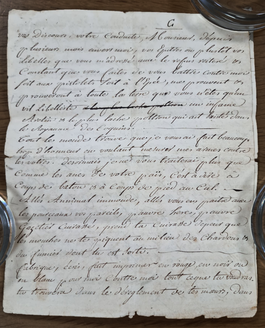
Translation
Your discourses, your behaviour to me for this many months, your Epistles or rather your libels which you address to me with the repeated and constant denial to fight me either with pistols or a sword convince me and will convince all the earth that you are nothing but a vile libeller…and the most cowardly poltroon that ever existed in the kingdom of the scoundrels…
…I’ll treat you only as they do your country asses, that is to say caning and kicking your arse with my foot. Go dirty animal, go and graze with the hogs your equals, poor beggar…
…Never forget that thou hadst been forced to burn and commit thyself in the furnace of Sodom and Gomorrah…
…Adieu for the last time coward, rogue, in the expectation that thou mayest soon give the mob of London thy blessing with thy broad feet at Tyburn and that thou hadst been promoted Campaign Bishop upon the doleful common of Hounslow Heath…
Your discourses, your behaviour to me for this many months, your Epistles or rather your libels which you address to me with the repeated and constant denial to fight me either with pistols or a sword convince me and will convince all the earth that you are nothing but a vile libeller…and the most cowardly poltroon that ever existed in the kingdom of the scoundrels…
…I’ll treat you only as they do your country asses, that is to say caning and kicking your arse with my foot. Go dirty animal, go and graze with the hogs your equals, poor beggar…
…Never forget that thou hadst been forced to burn and commit thyself in the furnace of Sodom and Gomorrah…
…Adieu for the last time coward, rogue, in the expectation that thou mayest soon give the mob of London thy blessing with thy broad feet at Tyburn and that thou hadst been promoted Campaign Bishop upon the doleful common of Hounslow Heath…
Letter sent by the Chevalier d’Eon to Charles de Morande, 8 August 1776. Catalogue reference: KB 1/20/6/1
‘Very well understands the French and the English languages’
When counsel for both sides appeared in court on 27 November 1776, they used the statements, letters, and newspapers now held in KB 1/20/6/1 to state their cases. As well as the letters written by d’Eon to Morande, the statements of Morande and his wife, as well as others, were also read out, presented as evidence of d’Eon’s character.
A final point to consider about d’Eon’s letters is that the passages read out in court were English translations. Both d’Eon and Morande were French, and so the personal letters between the two were also in French. To submit these letters to an English court as evidence, therefore, on 18 November another affidavit was taken from John Goy, a man who ‘very well understands the French and the English languages’. In his affidavit, Goy provides full translations of the letters, which were used by Charles de Morande in his statement. The original letters are enclosed in Goy’s translations in KB 1/20/6/1.
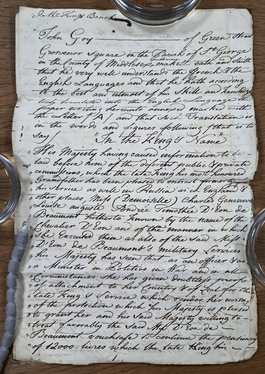
Transcript
In the King’s Bench.
John Goy of Green Street, Grosvenor Square, in the parish of St George in the county of Middlesex, gentleman, maketh oath and saith that he very well understands the French and the English languages and that he hath according to the best and utmost of his skill and knowledge truly translated into the English language the paper writing hereunto annexed marked with the Letter (A) and that such translation is in the words and figures following that is to say: “In the King’s Name” [etc]
…And this deponent further saith he hath also translated into English the two other papers and writings hereunto annexed respectively marked with the letters (B) and (C) and that the same are in the words and figures following…
In the King’s Bench.
John Goy of Green Street, Grosvenor Square, in the parish of St George in the county of Middlesex, gentleman, maketh oath and saith that he very well understands the French and the English languages and that he hath according to the best and utmost of his skill and knowledge truly translated into the English language the paper writing hereunto annexed marked with the Letter (A) and that such translation is in the words and figures following that is to say: “In the King’s Name” [etc]
…And this deponent further saith he hath also translated into English the two other papers and writings hereunto annexed respectively marked with the letters (B) and (C) and that the same are in the words and figures following…
Affidavit of the translator John Goy, 18 November 1776. Catalogue reference: KB 1/20/6/1
The affidavits in KB 1 provide unique perspectives on King’s Bench cases, supplementing plea rolls, indictments, and newspaper reports. In the November 1776 case against Morande, these records provide the original letters at the centre of Morande’s defence, affidavits sworn and signed by d’Eon, and copies of the newspapers that printed Morande’s libellous letter. But this is just one case among thousands. There is much more to discover in this rich and varied series.
Records featured in this article
-
- Title
- King’s Bench Plea Roll (Crown side) for Trinity term
- Date
- 1763–1764
-
- Title
- Draft Rule Books: 17 Geo III Michaelmas term
- Date
- 1776
Find out more
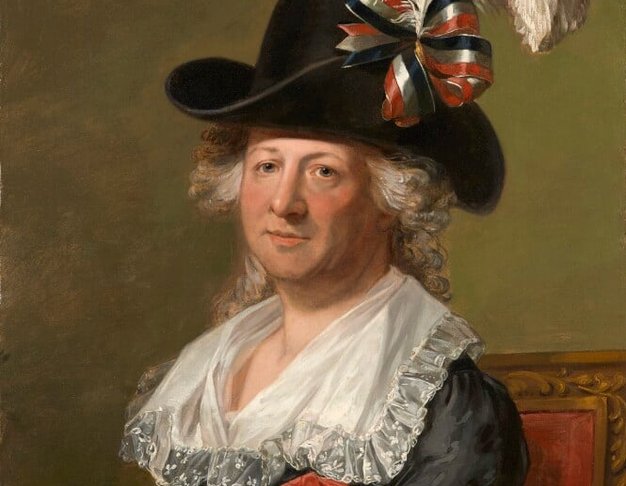
Online event: The Chevalier d’Eon in the English Law Courts
On Friday 14 February at 14.00, join Dan Gosling to find out more about the Chevalier d’Eon during this transitional period.
